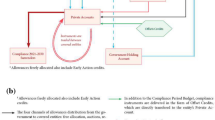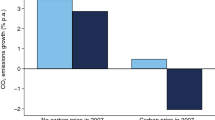Abstract
Facing requirements of sustainable development and tremendous international pressures, China has initiated a serious of trials for mandatory carbon trading schemes. In this study, to investigate the impact of carbon trading on commodity prices, emissions, outputs and profits of the regulated agents such as power plants in China, a partial equilibrium model is constructed based on the Cournot theory of oligopoly. Three key results were found. First, following the implementation of a carbon trading scheme there is a shift of production from plants with high emission rates to those with low rates. Second, the emission-based updating (EBU) allocation of allowable emissions would provide a buffer in which the reduced outputs and profits of plants with high emissions are alleviated. Third, if the electricity price is market oriented it will vary with the carbon price. Based on these results, we conclude that the carbon constraint will result in cleaner generating technologies and be helpful in promoting the development of low carbon technologies in China. In addition, the EBU allocation is more feasible at the beginning of the national carbon trading in China. Given that electricity prices in China are regulated now, we argue that mandatory carbon trading should be implemented at the beginning of coordinated reforms of market-oriented pricing in electricity.


Similar content being viewed by others
Notes
It is available at http://mnc.people.com.cn/h/2011/1204/c227933-3627707023.html.
It is the average price of the spot market in China Emissions Exchange from June 18 in 2013 to April 30 in 2014.
It is from Annual Report of Chinese Power Regulation (2011) published by State Electricity Regulatory Commission.
References
Bernstein S, Betsill M, Hoffmann M, Paterson M (2010) A tale of two Copenhagens: carbon markets and climate governance. Millennium-J of Int Stud 39(1):161–173
Bode S (2006) Multi-period emissions trading in the electricity sector-winners and losers. Energy Policy 34(6):680–691
Böhringer C, Lange A (2005) On the design of optimal grandfathering schemes for emission allowances. Eur Econ Rev 49(8):2041–2055
Bovenberg A, Goulder LH (2001) Neutralizing the adverse industry impacts of CO2 abatement policies: what does it cost? In: Carraro C, Metcalf GE (eds) Behavioral and distributional effects of environmental policy. University of Chicago Press, Chicago
Burtraw D, Palmer K, Bharvirkar R, Paul A (2002) The effect on asset values of the allocation of carbon dioxide emission allowances. Electr J 15(5):51–62
Burtraw D, Kahn D, Palmer K (2006) CO2 Allowance allocation in the regional greenhouse gas initiative and the effect on electricity investors. Electr J 19(2):79–90
Callon M (2009) Civilizing markets: carbon trading between in vitro and in vivo experiments. Acc Organ Soc 34(3):535–548
Chernyavs’ka L, Gullì F (2008) Marginal CO2 cost pass-through under imperfect competition in power markets. Ecol Econ 68(1):408–421
Convery FJ (2009) Reflections—the emerging literature on emissions trading in Europe. Rev Environ Econ Policy 3(1):121–137
Cramton P, Kerr S (2002) Tradeable carbon permit auctions: how and why to auction not grandfather. Energy Policy 30(4):333–345
Delarue E, Lamberts H, D’haeseleer W (2007) Simulating greenhouse gas (GHG) allowance cost and GHG emission reduction in Western Europe. Energy 32(8):1299–1309
Delarue E, D’haeseleer W (2008) Greenhouse gas emission reduction by means of fuel switching in electricity generation: addressing the potentials. Energy Convers Manag 49(4):843–853
Demailly D, Quirion P (2006) CO2 abatement, competitiveness and leakage in the European cement industry under the EU ETS: grandfathering versus output-based allocation. Clim Pol 6(1):93–113
Demailly D, Quirion P (2007) European emission trading scheme and competitiveness: a case study on the iron and steel industry. Energy Econ 30(4):2009–2027
Fan J, Zhao DT, Wu YR, Wei JC (2014) Carbon pricing and electricity market reforms in China. Clean Techn Environ Policy 16(5):921–933
Fezzi C, Bunn DW (2009) Structural interactions of European carbon trading and energy prices. The J of Energy Markets 2(4):53–69
Fischer C, Fox AK (2007) Output-based allocation of emissions permits for mitigating tax and trade interactions. Land Econ 83(4):575–599
Fowlie M (2011) Updating the allocation of greenhouse gas emissions permits in a federal cap-and-trade program. In: Fullerton D, Wolfram C (eds) The design and implementation of US climate policy. University of Chicago Press, Chicago
Government of China (2011) China’s 12th Five-Year Plan on national economic and social development (2011–2015). Beijing: Government of China. Available at: http://www.gov.cn/2011lh/content_1825838.htm
Grubb M, Neuhoff K (2006) Allocation and competitiveness in the EU emissions trading scheme: policy overview. Clim Pol 6(1):7–30
Hahn RW, Stavins RN (2011) The effect of allowance allocations on cap-and-trade system performance. J Law Econ 54(4):S267–S294
Haites E (2003) Output-based allocation as a form of protection for internationally competitive industries. Clim Pol 3:S29–S41
He YX, Huang WJ, Tan ZF, Wang Y, Huang H (2004) A study on demand of electricity reserve market in marketing operation. Proc of the Chin Soc of Electr Eng 24(3):46–50
Hurwicz L (1972) On informationally decentralized systems. In: McGuire CB, Radner R (eds) Decision and organization. North-Holland, Amsterdam
Hurwicz L (1973) The design of mechanisms for resource allocation. Am Econ Rev 63(2):1–30
Hurwicz L, Reiter S (2006) Designing economic mechanisms. Cambridge University Press, Cambridge, UK
Islegen Ö, Reichelstein S (2011) Carbon capture by fossil fuel power plants: an economic analysis. Manag Sci 57(1):21–39
Kan H, Chen R, Tong S (2012) Ambient air pollution, climate change, and population health in China. Environ Int 42:10–19
Laurikka H, Koljonen T (2006) Emissions trading and investment decisions in the power sector—a case study in Finland. Energy Policy 34(9):1063–1074
Le Quéré C, Peters GP, Andres RJ, Andrew RM, Boden T, Ciais P, Friedlingstein P, Houghton RA, Marland G, Moriarty R, Sitch S, Tans P, Arneth A, Arvanitis A, Bakker DCE, Bopp L, Canadell JG, Chini LP, Doney SC, Harper A, Harris I, House JI, Jain AK, Jones SD, Kato E, Keeling RF, Klein Goldewijk K, Körtzinger A, Koven C, Lefèvre N, Omar A, Ono T, Park G-H, Pfeil B, Poulter B, Raupach MR, Regnier P, Rödenbeck C, Saito S, Schwinger J, Segschneider J, Stocker BD, Tilbrook B, van Heuven S, Viovy N, Wanninkhof R, Wiltshire A, Zaehle S, Yue C (2014) Global carbon budget 2013. Earth Syst Sci Data 6:235–263
Lo AY (2013) Carbon trading in a socialist market economy: Can China make a difference? Ecol Econ 87:72–74
Martinez KK, Neuhoff K (2005) Allocation of carbon emission certificates in the power sector: how generators profit from grandfathered rights. Clim Pol 5(1):61–78
Neuhoff K, Martinez KK, Sato M (2006) Allocation, incentives and distortions: the impact of EU ETS emissions allowance allocations to the electricity sector. Clim Pol 6(1):73–91
Newell RG, Pizer WA, Raimi D (2013) Carbon markets 15 years after kyoto: Lessons learned, new challenges. J Econ Perspect 27(1):123–146
Perdan S, Azapagic A (2011) Carbon trading: current schemes and future developments. Energy Policy 39(10):6040–6054
Peters GP, Andrew RM, Boden T et al (2013) The challenge to keep global warming below 2 °C. Nat Clim Chang 3(1):4–6
Rosendahl KE (2008) Incentives and prices in an emissions trading scheme with updating. J Environ Econ Manag 56:69–82
Sijm JPM, Bakker JA, ChenY, Lise W, Harmsen HW (2005) CO2 price dynamics: the implications of EU emissions trading for the price of electricity. ECN Report ECN-C-05-081, Energy Research Centre of the Netherlands, Petten, the Netherlands
Sijm J, Neuhoff K, Chen Y (2006) CO2 cost pass-through and windfall profits in the power sector. Clim Pol 6(1):49–72
Skjærseth JB, Wettestad J (2008) EU emissions trading: initiation, decision-making and implementation. Ashgate Publishing Limited, England
Stavins RN (2003) Experience with market-based environmental policy instruments. Handb Environ Econ 1:355–435
Stolaroff JK, Weber CL, Scott Matthews H (2009) Design issues in a mandatory greenhouse gas emissions registry for the United States. Energy Policy 37(9):3463–3466
Tietenberg T (2010) The evolution of emissions trading. In: Siegfried JJ (ed) Better living through economics. Harvard University Press, Cambridge
Vithayasrichareon P, Mills G, MacGill I (2012) Assessing the potential role of large-scale PV generation and electric vehicles in future low carbon electricity industries. Change 4:5
Wadud Z, Noland RB, Graham DJ (2008) Equity analysis of personal tradable carbon permits for the road transport sector. Environ Sci Pol 11(6):533–544
Zhao XK (2013) Several issues on carbon emissions trading system design. South Chin Rural Area 29(3):27–32
Zhao J, Hobbs BF, Pang JS (2010) Long-run equilibrium modeling of emissions allowance allocation systems in electric power markets. Oper Res 58(3):529–548
Zhou X, James G, Liebman A et al (2010) Partial carbon permits allocation of potential emission trading scheme in Australian electricity market. Power Syst, IEEE Trans on 25(1):543–553
Acknowledgments
The authors acknowledge the National Natural Science Foundation of China (71301157, 71171183, and 71172213) for their generous financial support.
Author information
Authors and Affiliations
Corresponding author
Rights and permissions
About this article
Cite this article
Zhou, Y., Fan, J., Zhao, D. et al. The impact of carbon trading on regulated agents in China. Mitig Adapt Strateg Glob Change 21, 377–390 (2016). https://doi.org/10.1007/s11027-014-9604-1
Received:
Accepted:
Published:
Issue Date:
DOI: https://doi.org/10.1007/s11027-014-9604-1




